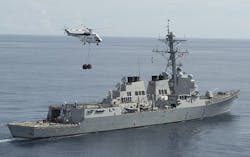12-company $800 million Navy project seeks to share radar, EW, and communications antennas
ARLINGTON, Va., 26 April 2016. Twelve U.S. technology companies are carrying out a 5-year potential $800 million U.S. Navy research project to develop new kinds of antennas that communications, radar, and electronic warfare (EW) systems can share.
Officials of the Office of Naval Research on Monday chose the 12 companies to participate in the Electromagnetic Command and Control (EMC2) program that seeks close integration of disparate RF system electronics and antennas to reduce costs and RF interference.
The idea is to reduce the number of RF and microwave antennas on ships, aircraft, ground vehicles, and land sites to mitigate the effects of RF interference, as well as reducing the costs of military systems that use radio waves.
The companies selected for the (EMC2) are:
the Lockheed Martin Corp. Mission Systems and Training segment in Moorestown, N.J.;
ArgonST, a wholly owned subsidiary of the Boeing Co. in Fairfax, Va.;
the Northrop Grumman Corp. Mission Systems segment in Linthicum, Md.;
the Raytheon Co. Integrated Defense Systems Advanced Technology Programs segment in Tewksbury, Mass.;
EOIR Technologies Inc. in King George, Va.;
SI2 Technologies Inc. in North Billerica, Mass.;
S2 Corp. in Bozeman, Mont.;
Sea Corp. in Middletown, R.I.;
Leidos in Arlington, Va.;
Rockwell Collins in Cedar Rapids, Iowa;
Physical Optics Corp. (POC) in Torrance, Calif.; and
TiCom Inc. in Austin, Texas.
In the EMC2 program Navy researchers are trying to capitalize on work done in the Integrated Topside (InTop) shipboard antenna program, which sought to develop integrated shipboard RF antennas able to handle several different warfare areas.
Related: Electromagnetic spectrum sharing among radar and communications systems moving forward
The EMC2 program, however, seeks to move beyond InTop by developing and demonstrating system prototypes that integrate the RF functionality of EW, radar, communications, and information operations into a common set of open-systems antennas, electronics, and software.
This is an attempt to head-off widespread development of stand-alone RF and microwave systems that each require a separate antenna. This approach is expensive, wastes space, and often subjects RF systems to interference from the others.
Prototypes should be able to provide several simultaneous and independent RF and microwave beams that can work together to perform EW, radar, communications, and wireless information exchange. Researchers want to integrate these new prototypes with InTop or other RF combat systems.
The goal is to provide these integrated RF and microwave systems with resource allocation, real time spectrum operations, emissions control, and electromagnetic maneuver so that Navy RF systems can work together.
This capability should be able to monitor the RF spectrum across a wide range of frequencies and reallocate functions to the best frequency in response to changes in the electromagnetic environment for intelligence gathering, cyber warfare, command and control, EW, situational awareness, and battle management.
The project will involve establishing open-systems interfaces between system software, firmware, and hardware; develop system prototypes for deployment on surface ships, aircraft, and submarines; and establish the ability to integrate new electromagnetic systems with existing systems.
The 12 EMC2 contractors will compete for task orders under terms of the contract, which will conclude in April 2021.
The contractors will build prototypes that integrate RF functionality EW, radar, voice, and data communications into a common set of multi-function apertures, electronics, software, and firmware in a modular architecture that is scalable across platforms and open at the RF, electronics, software, firmware levels, Navy officials say.
Related: High-speed networking upgrade helps EA-18G jets share electronic intelligence in real time
These prototypes will be able to generate simultaneous independent beams that work together to provide radar, EW, voice, and data communications functions.
The contractors will integrate their prototypes with previously developed InTop and other RF and C4ISR systems to enable resource allocation, real time spectrum operations, emissions control, and electromagnetic maneuver.
For more information contact the Office of Naval Research online at www.onr.navy.mil.

